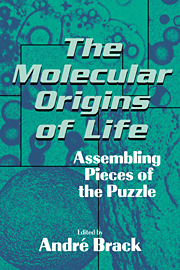Introduction
Published online by Cambridge University Press: 06 January 2010
Summary
Humans in every civilization have always been intrigued by their origin and by the question of the origin of life itself. During thousands of years, the comforting theory of spontaneous generation seemed to provide an answer to this enduring question. In ancient China, people thought that aphids were spontaneously generated from bamboos. Sacred documents from India mention the spontaneous formation of flies from dirt and sweat. Babylonian inscriptions indicate that mud from canals was able to generate worms.
For the Greek philosophers, life was inherent to matter; it was eternal and appeared spontaneously whenever the conditions were favorable. These ideas were clearly stated by Thales, Democritus, Epicurus, Lucretius, and even by Plato. Aristotle gathered the different claims into a real theory. This theory safely crossed the Middle Ages and the Renaissance. Famous thinkers like Newton, Descartes, and Bacon supported the idea of spontaneous generation.
The first experimental approach to the question was published in the middle of the 17th century, when the Flemish physician Van Helmont reported the generation of mice from wheat grains and a sweat-stained shirt. He was quite amazed to observe that the mice were identical to those obtained by procreation. A controversy arose in 1668 when Redi, a Tuscan physician, published a set of experiments demonstrating that maggots did not appear when putrefying meat was protected from flies by a thin muslin covering.
Six years after Redi's treatise, the Dutch scientist Anton Van Leeuwenhoek observed microorganisms for the first time through a microscope of his own making. From then on, microorganisms were found everywhere and the supporters of spontaneous generation took refuge in the microbial world.
- Type
- Chapter
- Information
- The Molecular Origins of LifeAssembling Pieces of the Puzzle, pp. 1 - 10Publisher: Cambridge University PressPrint publication year: 1998



